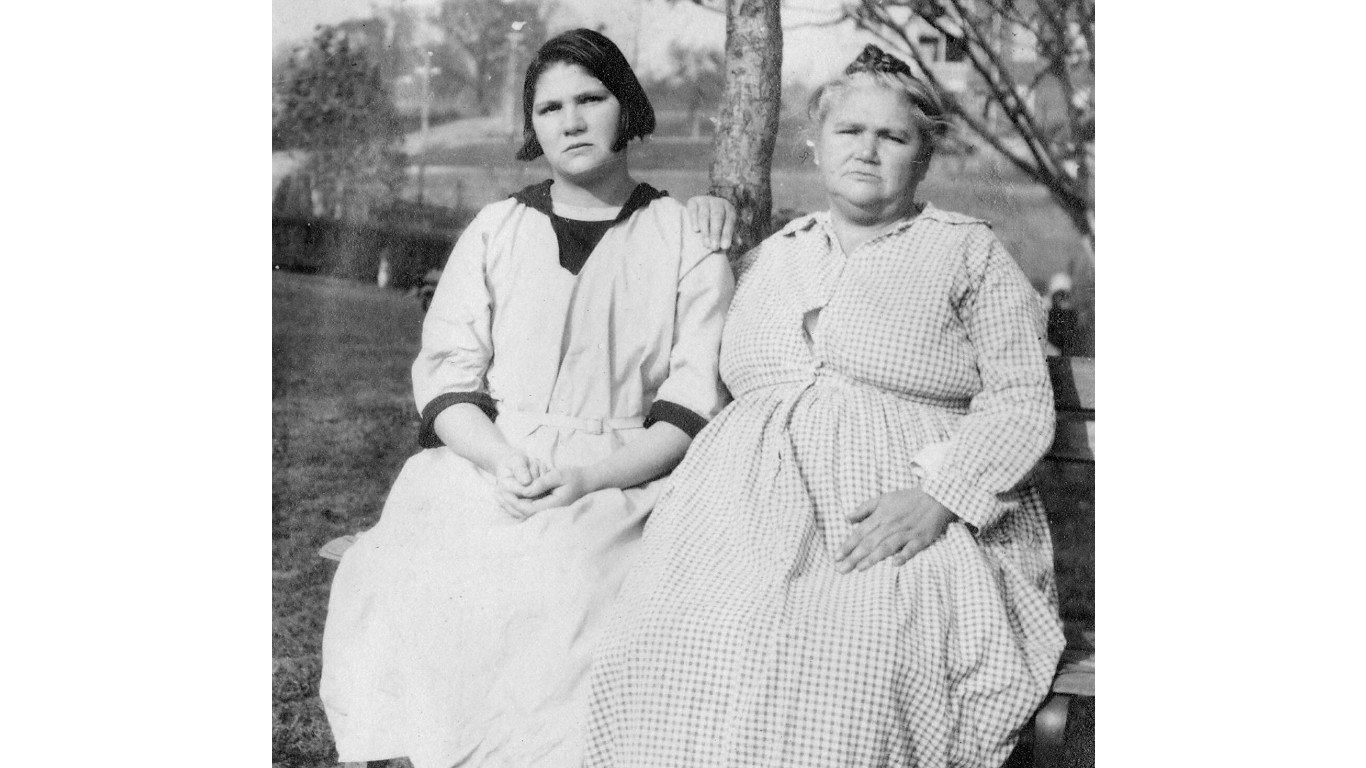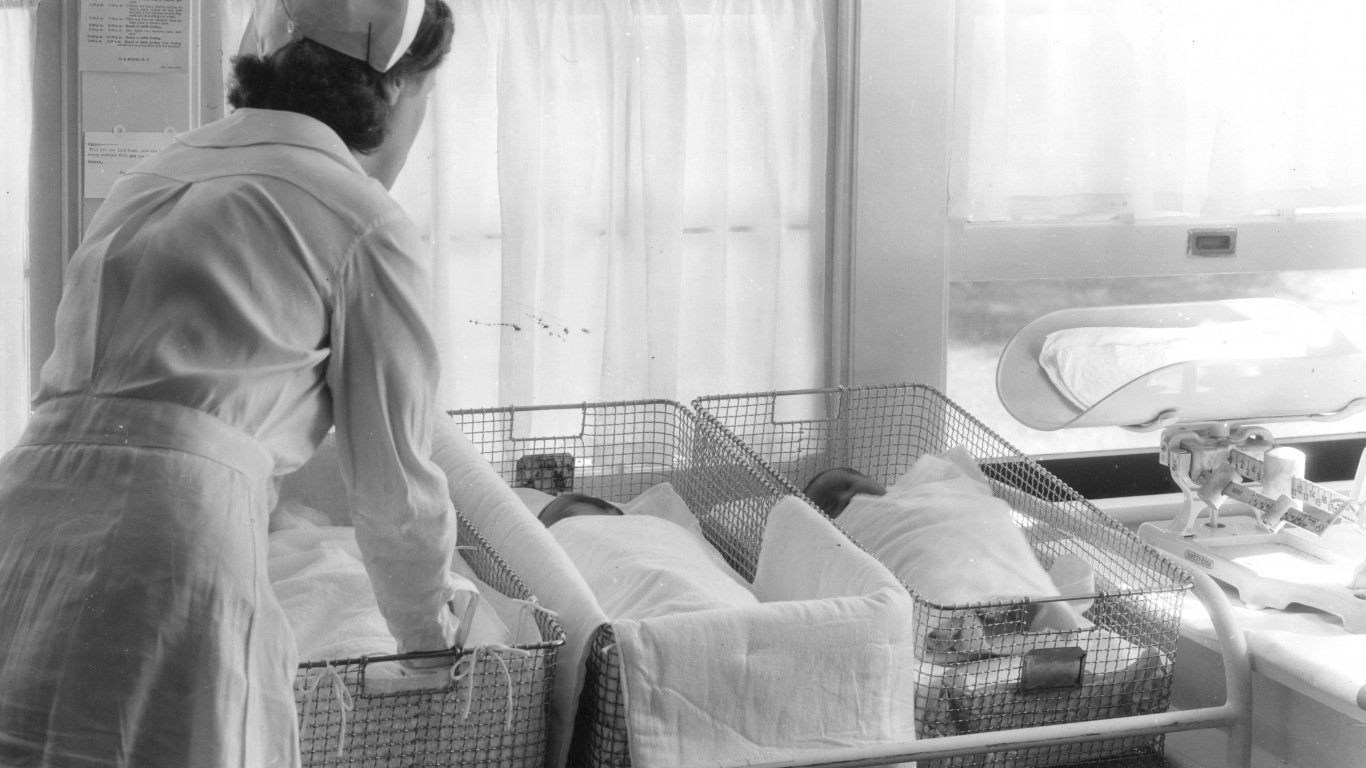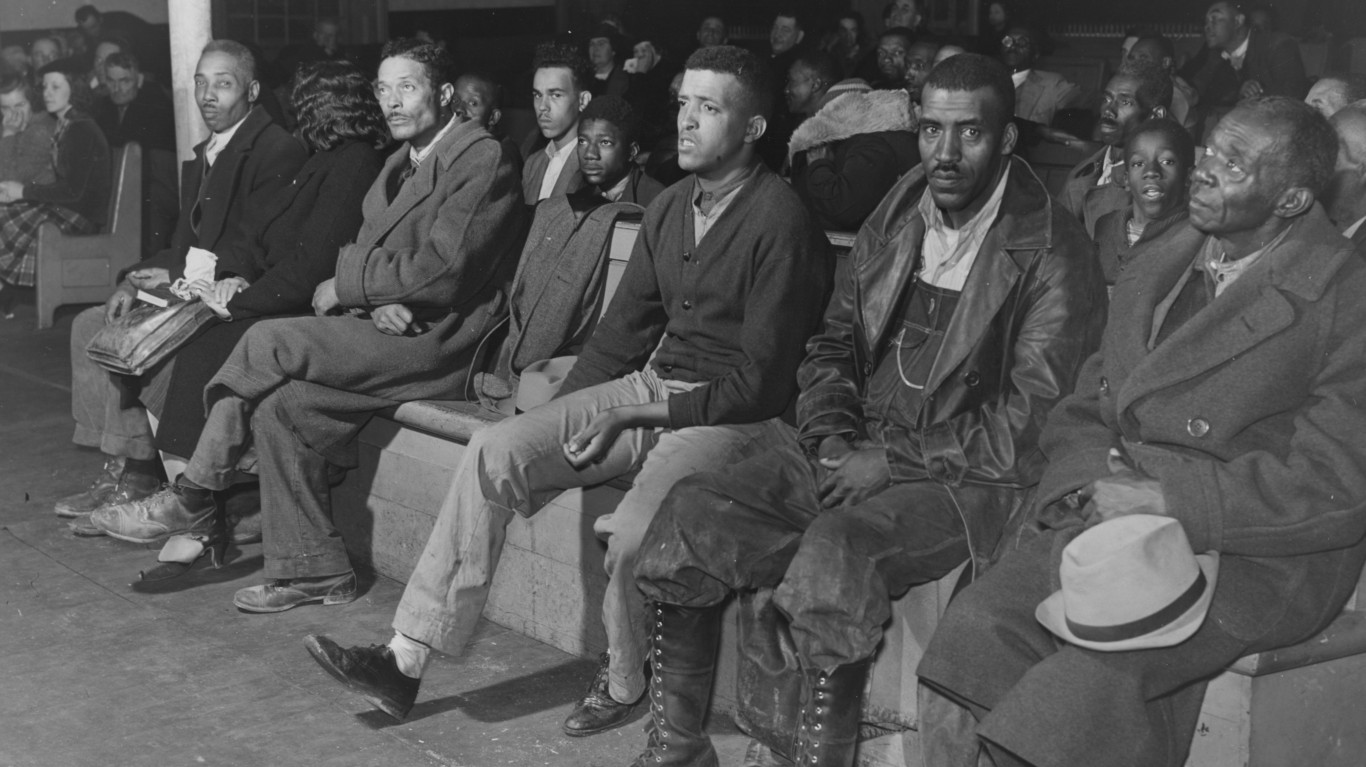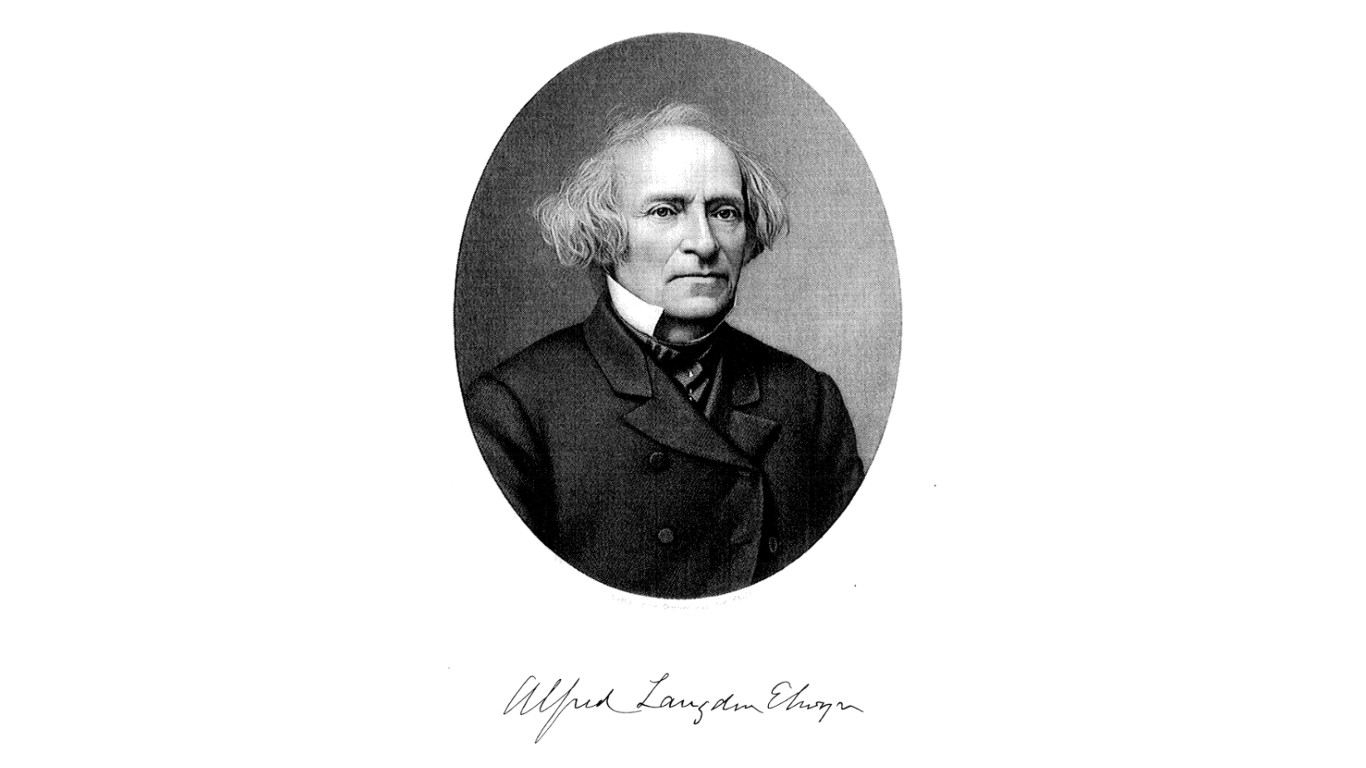
The field of eugenics — a word derived from the Greek for “well-born” or “of good birth” — was introduced in England in 1883 by a polymath named Francis Galton, a half-cousin of Charles Darwin. He coined the term and wrote a book about selective breeding in humans. Like horses and dogs, he proposed, people could be bred to promote positive characteristics, such as intelligence. (They can’t, but animals probably can. These are the smartest dog breeds in America.)
In the United States a movement grew out of Galton’s ideas, but with a different twist; eugenics offered an argument for keeping people with unfavored characteristics from having children. The concept gained popularity in the 1920’s and ‘30’s, supported by academics, scientists, and the progressive movement. A few states began to pass laws allowing for the compulsory segregation and sterilization of people seen as unfit to reproduce. Advocates argued that this practice was beneficial, not only to society at large, but to the victims, who would be spared the responsibility of raising children.
In 1927, a single sterilization in Virginia changed the course of the eugenics movement, giving it legitimacy and momentum. Carrie Buck, a 17-year-old inmate of the Virginia State Colony for Epileptics and Feebleminded, had given birth to a child — deemed feebleminded at six months of age — as a result of rаpe by a foster family member. Like her mother and daughter, Buck was considered mentally deficient and authorities ordered that she be sterilized to avoid future pregnancies.
Buck challenged the order and her case went to the Supreme Court, which allowed the sterilization to proceed. The court held that, “It is better for all the world…if society can prevent those who are manifestly unfit from continuing their kind.” In the infamous concluding words of Justice Oliver Wendell Holmes, “Three generations of imbeciles is enough.”
The case won wider acceptance for eugenics, and the number of sterilizations increased dramatically throughout the U.S. into the 1930’s and beyond. Some 32 states eventually adopted legally documented eugenics programs involving sterilization, usually forced. (Fortunately, the promotion of eugenics doesn’t need to be included in our listing of the worst thing about every state.)
Click here to see 32 states that used to sterilize their citizens
Poor people like Carrie Buck — and women in particular — were the primary victims. Foreigners and people of color were also targeted. Under the laws of most states, homosexuals, epileptics, criminals, the mentally deficient, and the insane, mostly from institutions and asylums, could be forcibly sterilized. Even when consent was required, it was often a quid pro quo for gaining release from a facility.
While sterilizations were still performed well beyond World War II, the Holocaust and mass forced sterilization in Nazi Germany (a practice influenced by American practices) helped end popular support for sterilization, and the 1960’s and ‘70’s saw the repeal of most state eugenics laws. In 2013, North Carolina became the first state to express regret for its eugenics history by setting up a fund to compensate victims still living.
Information on the 32 states with sterilization programs — including the number and sex of victims, the years programs were in effect, and specific details about laws and practices in each state — is drawn from research conducted by two groups of honors students at the University of Vermont as edited and amended by Lutz Kaelber, an associate professor of sociology at the university.
1. Alabama
> Number of victims: 224 (58% male, 42% female)
> Years of sterilizations: 1919 – 1935
Generally speaking, the Deep South was not enthusiastic about eugenics, due in large part to religious traditions and a culture of strong, nurturing families. Still, William Partlow, an ardent believer in ridding the population of “defectives,” coaxed the Medical Association of the State of Alabama to work with him in passing a bill that created the Alabama Home for the Feeble-minded, and, in the fine print, granted the superintendent of the school the discretion to order the sterilization of patients. Partlow became the superintendent in 1920 and sterilized every inmate in his charge.
[in-text-ad]

2. Arizona
> Number of victims: 30 (67% male, 33% female)
> Years of sterilizations: 1929 – 1956
An Arizona law passed in 1929 provided for the sterilization of people “afflicted with hereditary forms of insanity that are recurrent, idiocy, imbecility, feeble-mindedness, or epilepsy” and had the potential to produce “likewise afflicted” children. Unlike the Alabama law, the Arizona statute offered some due process, whereby the recommendation for sterilization by the Superintendent of the State Hospital had to be approved by the State Board of Medical Examiners, whose confirmation of disability could be appealed in court within 30 days.
3. California
> Number of victims: 20,108 (50% male, 50% female)
> Years of sterilizations: 1909 – 1950
California passed its first sterilization law in 1909 and additional laws in 1913 and 1917, each expanding the scope of who could be neutered. A California court case in 1930 affirmed the right of a mother to have her daughter sterilized for sexual misconduct, effectively expanding the permissible reasons for sterilization beyond hereditary concerns. Even considering questionable record-keeping that suggests that the number may be higher, California sterilized over 20,000 people, the most of any state, and a third of the U.S. total.

4. Connecticut
> Number of victims: 557 (3% male, 97% female)
> Years of sterilizations: 1909 – 1963
Connecticut was the second state to pass a eugenics law, allowing a panel of surgeons to order the sterilization of mental hospital patients after reviewing patients’ family history, chances of recovery, and potential for procreation. The Connecticut law is distinguished from others in that its female victims had to undergo the complete removal of their ovaries , while other states called for removal of the fallopian tubes.
[in-text-ad-2]

5. Delaware
> Number of victims: 945 (50% male, 50% female)
> Years of sterilizations: 1923 – 1963
Delaware came late to the practice of eugenics but did so enthusiastically, with the highest per capita rate of sterilization in the country in some years. Victims included mental hospital patients who were “insane, feeble minded or epileptic,” homosexuals, and habitual criminals if their criminality was “due to mental abnormality.” The statute required families to be notified, and stipulated that patients be consulted and be allowed to object. The numbers indicate that these requirements may not have been scrupulously honored; in other states sterilizations dropped precipitously when consent became the rule.

6. Georgia
> Number of victims: 3,284 (45% male, 55% female)
> Years of sterilizations: 1937 – 1963
Georgia was the last state to embrace eugenics, with its culture of large extended families that took care of their own. Progressivism had not made inroads in the state and a previous version of the sterilization bill had been vetoed by Governor Eugene Talmadge. The law that passed in the subsequent administration targeted individuals who “would be likely, if released without sterilization, to procreate a child, or children, who would have a tendency to serious physical, mental, or nervous disease or deficiency.”
It appears that race was not a factor in Georgia’s eugenics. The patients in institutions from which victims were drawn were overwhelmingly white. A progressive Georgia politician, Ellis Arnell, was an advocate of both compulsory sterilization and African-American voting rights.
[in-text-ad]

7. Idaho
> Number of victims: 38 (22% male, 78% female)
> Years of sterilizations: 1933 – 1963
Idaho’s first eugenics law was passed in 1925, allowing sterilization of “feeble-minded, insane, epileptics, habitual criminals, moral degenerates and sexual perverts,” who could potentially pass on these conditions or otherwise constitute “a menace to society.” In practice, sterilizations were few because they required the consent of the victim or a guardian, or, alternatively, a hearing based on an examination by a single doctor. The doctor’s main obstacle in making a case for sterilization was in proving heritability.

8. Illinois
> Number of victims: 1 (100% male, 0% female)
> Years of sterilizations: 1916 – 1916
Illinois never passed a sterilization law. The only known case of state sanctioned sterilization involved a 65-year-old convicted prisoner deemed to be a “sexual pervert and degenerate.” The sentencing judge gave him the option of prison or sterilization. The prisoner chose the latter. It is believed that the judge intended the sentence and the publication of his order to spark debate on sterilization. The debate continued over the years, with three eugenics bills introduced, but ultimately defeated, between 1925 and 1933, supported by progressives.
9. Indiana
> Number of victims: 2,500 (48% male, 52% female)
> Years of sterilizations: 1907 – 1974
Before there was a eugenics law in Indiana, Dr. Harry C. Sharp, a noted proponent of sterilization, was already practicing the procedure on male prison and reformatory inmates guilty of mаsturbation or other sexual “deviance.” His interest was not in punishment, he said, but in helping his victims. He chose vasectomy over castration so that his patients would not be depressed by the ever-present reminder of their neutering. Historians estimate these early procedures to have numbered between 175 and 800.
[in-text-ad-2]

10. Iowa
> Number of victims: 1,910 (33% male, 67% female)
> Years of sterilizations: 1910 – 1963
Iowa was the birthplace and childhood home of Harry H. Laughlin, a prolific writer and highly influential national and international proponent of eugenics. Like many other states, Iowa followed Laughlin’s guidance in the passage and execution of its sterilization laws, but not without pushback.
The Women’s Christian Temperance Union in Iowa argued, based on growing research, that environment and nurturing could improve a child’s IQ, and that sterilization cruelly cut off a person’s potential. The Catholic Church also weighed in against proposed sterilizations brought before the State Eugenics Board, succeeding in getting many dismissed.
11. Kansas
> Number of victims: 3,032 (42% male, 58% female)
> Years of sterilizations: 1913 – 1961
In the 1890’s, before the passage of the first sterilization laws in Kansas, Dr. F. Hoyt Pilcher, the superintendent of the Kansas Home for the Feeble-minded, later named the Kansas State Asylum for Idiotic and Imbecile Youth, was found to be “de-sexing” his “students” — so called because of the institution’s educational goals. He performed up to 150 sterilizations, including 58 castrations, before he was removed from his position. He was subsequently reappointed in the face of widespread fear of degeneracy. The early sterilization laws did not precipitate a large number of procedures, due at least in part to the outcry over Pilcher’s notorious history. After the U.S. Supreme Court endorsed compulsory sterilization in the infamous Carrie Buck case, however, incidences of the procedure soared.
[in-text-ad]

12. Maine
> Number of victims: 326 (14% male, 86% female)
> Years of sterilizations: 1925 – 1963
Maine’s sterilization laws, passed in 1925, allowed physicians to propose sterilization, to be approved by a state board, and then subject to appeal. The law also allowed individuals or their families to request sterilization, and the requests had to be approved by a committee of three doctors. Prior to 1930, Maine’s laws also prevented marriage of “idiots, imbeciles, and feebleminded” individuals, without defining those terms. Any instance of such a marriage was considered void because of the participant’s assumed inability to make a contract.

13. Michigan
> Number of victims: 3,786 (26% male, 74% female)
> Years of sterilizations: 1914 – 1963
After a 1913 law was declared unconstitutional, a 1923 eugenics law was upheld, allowing both voluntary and compulsory sterilization, by vasectomy, salpingectomy (surgical removal of fallopian tubes), and x-ray, of “idiots, imbeciles and feebleminded.” The law was amended in 1929 to include the insane, epileptics, “moral degenerates,” and “sexual perverts,” and to allow the castration of the latter as a “more humane procedure.”

14. Minnesota
> Number of victims: 2,350 (22% male, 78% female)
> Years of sterilizations: 1928 – 1963
Before the explicit recognition of eugenics in state law, a 1917 statute allowed probate judges to commit people “alleged to be Feeble minded, Inebriate, or Insane” — as well as neglected or delinquent children — to state guardianship. The guardianship was for life, providing a pool of candidates for the 1925 sterilization law, which targeted institutionalized “insane” and “feebleminded.” Consent of a spouse or next of kin was required, but it appears that family members were given to believe that the loved one’s release would be more likely if sterilization was performed.
[in-text-ad-2]

15. Mississippi
> Number of victims: 683 (33% male, 77% female)
> Years of sterilizations: 1933 – 1963
Like other Southern states, Mississippi was not an early adopter of eugenics policies, and when it did pass a law in 1928 allowing sterilization, the procedures for ordering sterilization discouraged the superintendents of asylums from seeking them. The superintendent would first have to seek approval by the board of the institution and then the inmate had to be given notice and a hearing at which the inmate, the inmate’s guardian, or counsel could dispute the proposal. An adverse ruling could be appealed all the way to the state supreme court.

16. Montana
> Number of victims: 256 (28% male, 72% female)
> Years of sterilizations: 1923 – 1954
Similar to most states, Montana’s 1923 law targeted inmates of state institutions who were “hereditary idiots, feeble-minded, insane, and epileptics,” and provided a process for ordering compulsory sterilizations. In practice, the state’s mental institutions claimed not to perform these procedures without the consent of the patient or a family member, though it is reported that they would often go to great lengths to obtain consent. The statute was replaced in 1969 with a new law that explicitly required a patient’s consent. Still, following its passage, 66 people were sterilized for being incapable of caring for children or likely to pass on undesirable traits.
[in-text-ad]
17. Nebraska
> Number of victims: 902 (47% male, 53% female)
> Years of sterilizations: 1917 – 1963
While most states limited the pool of sterilization candidates to the inmates of a few named asylums, Nebraska’s 1915 law allowed for sterilization of the insane or feebleminded from a range of state facilities, including “institutions for the feeble-minded, hospitals for the insane, the penitentiary, reformatory, industrial schools, the industrial home, and other such State institutions.” A replacement law in 1929 expanded the target population to include “habitual criminals, moral degenerates, and sexual perverts.” A final version of the statute in 1957 effectively limited sterilizations to residents of a single home for “mental deficients,” thereby removing habitual criminals and the insane from the scope of the law.

18. New Hampshire
> Number of victims: 697 (10% male, 90% female)
> Years of sterilizations: 1910 – 1959
The first two sterilization laws in New Hampshire, enacted in 1917 and 1921, emphasized patients’ rights and included procedural safeguards. In 1929, in the wake of the Supreme Court ruling in the case of Carrie Buck, a new law was adopted that permitted compulsory sterilization. By the 1950’s, eugenics was losing its popularity among New Hampshire physicians, and the number of sterilizations was reduced, and usually performed by consent.

19. New York
> Number of victims: 42 (1% male, 99% female)
> Years of sterilizations: 1912 – 1920
New York’s sterilization law was short-lived, ending in repeal after a court case exposed the gross unfairness of the practice. In Osborn v. Thompson, the plaintiff, an asylum inmate considered feebleminded, was “voluntarily” sterilized. In a challenge to the statute, his counsel argued that nobody with Osborn’s alleged deficiency who lived outside of an institution was subject to sterilization. Based on this argument, the court found that the statute violated the 14th amendment to the Constitution, which requires equal protection under the laws.
[in-text-ad-2]

20. North Carolina
> Number of victims: 7,600 (15% male, 85% female)
> Years of sterilizations: 1929 – 1973
North Carolina had the third highest number of sterilizations of any state. Unlike most of the others, North Carolina, in addition to allowing institutions to order sterilization, permitted the guardian or next of kin of an individual considered feebleminded or insane to petition for that person’s sterilization. Under the original 1929 law, a petition for sterilization had to be approved by two named public officials and the chief medical officers of any two state institutions for the feeble-minded or insane, who together considered whether it was “likely that the individual might produce children with mental or physical problems.” The law was subsequently declared unconstitutional. A 1933 revision added due process safeguards, including review by a larger panel, representation of the patient at a hearing, and an appeals process.

21. North Dakota
> Number of victims: 1,049 (38% male, 62% female)
> Years of sterilizations: 1913 – 1962
Following a pattern in many states, North Dakota’s 1913 law, passed as “an act to prevent procreation of confirmed criminals, insane, idiots, defectives, and rаpists…” was later replaced with a law that expanded the pool of sterilization candidates, but also added procedures meant to provide due process. Epileptics were removed from the list in 1961. As part of the eugenics movement, another bill was introduced to create a registry of mentally defective persons. Listed individuals would be restricted in a number of civic activities, including the purchase of land, engaging in lawsuits, and acquiring a marriage license. The bill failed to pass the legislature.
[in-text-ad]
22. Oklahoma
> Number of victims: 556 (22% male, 78% female)
> Years of sterilizations: 1933 – 1955
Oklahoma’s list of sterilization candidates looked like those of most other states, but also included patients “likely to be a public or partial public charge.” An amendment to the law further provided that habitual criminals with two previous convictions could be forcefully sterilized. In 1942, in the landmark case of Skinner v. the State of Oklahoma, the Supreme Court held that forced sterilization was not an acceptable means of punishment for a crime. With this decision, Oklahoma sterilizations decreased precipitously.

23. Oregon
> Number of victims: 2,341 (35% male, 65% female)
> Years of sterilizations: 1921 – 1983
In the years before final passage of Oregon’s sterilization law, powerful lobbies formed on either side of the eugenics debate. The pro-sterilization faction advocated for a bill year after year beginning in 1907, and when a law passed 10 years later, the anti-sterilization faction forced a public referendum that overturned the law. A new version of the bill was passed in 1919 but was declared unconstitutional in 1921 by a court as violating the constitutional provision against cruel and unusual punishment. In 1923 the law was once again repackaged as being “non-punitive and therapeutic for both the patient and society.” Though it was very similar to its predecessor, this version withstood challenges and was in effect until it was repealed in 1983.
24. Pennsylvania
> Number of victims: 270 (% male unknown,% female unknown)
> Years of sterilizations: 1889 – 1931
Efforts to provide for legal sterilization were made in the Pennsylvania legislature in 1905, 1911, 1913, 1915, 1917, 1919, and 1921. A bill was passed in 1905, known as An Act for the Prevention of Idiocy, but was vetoed by Governor Samuel W. Pennypacker. A second bill, passed in 1921, was vetoed by Governor William Sproul as violating the 14th Amendment.
Even in the absence of legislation, 260 sterilizations are known to have taken place in Pennsylvania in the last century, all of them at the Pennsylvania Training School for Feeble-Minded Children at Elwyn. In the absence of records the gender of the victims is not known, nor the reasons for sterilization. It has been claimed that all such sterilizations were with the consent of the parents.
[in-text-ad-2]

25. South Carolina
> Number of victims: 277 (8% male, 92% female)
> Years of sterilizations: 1938 – 1963
As in most of the South, the culture of South Carolina was not receptive to sterilization, with families unwilling to have disabled children and other family members taken from their homes. When institutionalization was felt necessary, the early strategy for avoiding procreation by those deemed unfit was through segregation from society. South Carolina finally fell into step with most of the rest of the country as the second-to-last state to enact a sterilization law. It targeted the usual range of inmates from mental and penal institutions who were considered morally or mentally deficient or insane.

26. South Dakota
> Number of victims: 789 (33% male, 66% female)
> Years of sterilizations: 1921 – 1963
The original version of South Dakota’s law applied to a single asylum (though a 1950’s amendment added a state hospital), but a few years later it was amended to allow individuals outside the institution to be targeted for sterilization. Proposed victims from the general public could be given a choice between institutionalization or sterilization. Similarly, asylum inmates eligible for release could be made to choose between sterilization or continued residence at the facility.
[in-text-ad]

27. Utah
> Number of victims: 772 (46% male, 54% female)
> Years of sterilizations: 1925 – 1960
Utah’s first sterilization bill targeted “habitual sexual criminals, idiots, epileptics, imbeciles, and the insane,” but, due in part to Morman cultural influences and widespread homophobia, the law was amended in 1929, to add people with “habitual degenerate and sexual criminal tendencies.” The language was written to target homosexuals, but in the same year, a single court case, Warden Davis v. Esau Walton, neutered the amendment. A gay African-American inmate, imprisoned for theft, was caught in an act of sodomy with another prisoner. The warden recommended sterilization, and the reviewing court affirmed the law’s constitutionality. Still, the prisoner was not sterilized because there was no evidence presented that his homosexuality was heritable. The statute was clear that it was meant to be “eugenic and therapeutic.”

28. Vermont
> Number of victims: 253 (33% male, 66% female)
> Years of sterilizations: 1931 – 1957
A eugenics movement took hold in Vermont when it was determined in 1917 that, among the states, Vermont had one of the highest percentage of physical and mental “defectives” among its military draftees. The perceived deficiencies created a fear that Vermonters, who prided themselves on ruggedness, would be seen as inferior. Blame for societal weakness was placed on Native Americans and an influx of French Canadians.
When the state ultimately passed a law in 1931, providing for the sterilization of the usual candidates — “‘idiots’, ‘imbeciles’, ‘feeble-minded’ or ‘insane’ persons”– officials targeted the poor and families “outside the accepted moral or social convention of middleclass America,” which often translated to families with Abenaki or French Canadian bloodlines.
29. Virginia
> Number of victims: 7,325 (38% male, 62% female)
> Years of sterilizations: 1924 – 1979
The most famous victim of sterilization was Virginia’s Carrie Buck, the plaintiff in the Supreme Court decision in Buck v. Bell, which was received as a full-throated endorsement of compulsory sterilization from the highest level of government, written by Justice Oliver Wendell Holmes Jr., one of the country’s most esteemed jurists. Virginia wasted no time in passing a sterilization law after the decision was reached, and proceeded to use the law to target its poorest citizens, considered a threat to the purity of the “American Race.” According to chroniclers of the era, sheriffs were known to ride into remote villages in so-called mountain sweeps and remove individuals to institutions. The captives would be released only after consenting to sterilization, though many were unaware of the procedure’s purpose.
[in-text-ad-2]

30. Washington
> Number of victims: 685 (27% male, 73% female)
> Years of sterilizations: 1921 – 1942
Long before its comprehensive 1921 sterilization law, similar to those of other states, Washington was considered to have had the second sterilization law in the country, passed in 1909, but it was limited to punishing prisoners for sex crimes. A court ruling failed to find it cruel and unusual, focusing on the relatively painless procedure rather than its consequences.

31. West Virginia
> Number of victims: 98 (16% male, 84% female)
> Years of sterilizations: 1929 – 1956
West Virginia was one of the states that took an interest in sterilization for eugenics purposes following the Buck v. Bell decision. It passed a law but exercised it unenthusiastically, possibly because of the strict legal procedures that needed to be followed before a sterilization could be performed. Still the state saw a surge in sterilizations in the 1950s, during which half of the state’s 98 operations were performed.
[in-text-ad]

32. Wisconsin
> Number of victims: 1,823 (21% male, 79% female)
> Years of sterilizations: 1915 – 1963
The movement toward state-sanctioned sterilization in Wisconsin began in the 1890’s with the creation of a Home for the Feeble-Minded, where children and adults considered mentally deficient could be cared for and educated to the extent possible. When the center became overcrowded and expensive, and with the scientific community lauding the wisdom of eugenics, sterilization was seen as a means of permitting the release of inmates without fear that they would procreate.
After several failed attempts in earlier years, the state passed a sterilization law in 1913. The first director of the Home for the Feeble-Minded, Albert Wilmarth, was a proponent of sterilization over confinement. He is credited for his influence in the large number of sterilizations of “habitual criminals and unchaste women.”
In 20 Years, I Haven’t Seen A Cash Back Card This Good
After two decades of reviewing financial products I haven’t seen anything like this. Credit card companies are at war, handing out free rewards and benefits to win the best customers.
A good cash back card can be worth thousands of dollars a year in free money, not to mention other perks like travel, insurance, and access to fancy lounges.
Our top pick today pays up to 5% cash back, a $200 bonus on top, and $0 annual fee. Click here to apply before they stop offering rewards this generous.
Flywheel Publishing has partnered with CardRatings for our coverage of credit card products. Flywheel Publishing and CardRatings may receive a commission from card issuers.
Thank you for reading! Have some feedback for us?
Contact the 24/7 Wall St. editorial team.


 24/7 Wall St.
24/7 Wall St.



 24/7 Wall St.
24/7 Wall St.



